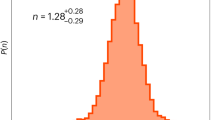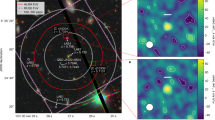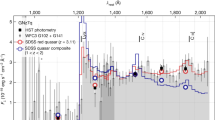Abstract
CONSEQUENCES of far reaching cosmological import have been inferred by Solheim1 from the incidence of radio sources in directions nearly opposite to those of known quasi-stellar objects. The evidence rests chiefly on (i) the frequency with which radio sources occur within one degree of the anti-position, in relation to that expected from a random distribution, and especially its enhancement for those quasars with red-shifts in the range 1.2⩽ z ⩽2.0, and (ii) the reduction below statistical expectation of the average value of the separations between the anti-positions and their associated sources, also occurring preferentially over the same range of red-shifts.
This is a preview of subscription content, access via your institution
Access options
Subscribe to this journal
Receive 51 print issues and online access
$199.00 per year
only $3.90 per issue
Buy this article
- Purchase on SpringerLink
- Instant access to full article PDF
Prices may be subject to local taxes which are calculated during checkout
Similar content being viewed by others
References
Solheim, J.-E., Nature, 219, 45 (1968).
Author information
Authors and Affiliations
Rights and permissions
About this article
Cite this article
PIPER, D. Radio Sources opposite Quasars as a Cosmological Test. Nature 219, 846–847 (1968). https://doi.org/10.1038/219846a0
Received:
Published:
Issue date:
DOI: https://doi.org/10.1038/219846a0
This article is cited by
-
Certain questions of Lobachevskii geometry, connected with physics
Journal of Soviet Mathematics (1984)
-
Inhomogeneous large-scale magnetic field and global structure of the Universe
Astrophysics (1977)
-
The red shift hypothesis for quasars: Is the earth the center of the universe?
Astrophysics and Space Science (1976)
-
Search for Ghost Images: a Statistical Test
Nature (1969)
-
Elliptische Räume und antipodische Radioquellen
Naturwissenschaften (1969)



